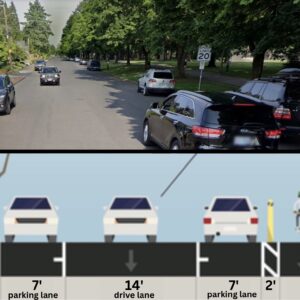No Teeth
The Oregon Bicycle and Pedestrian Plan is a sprawling document of how we got here. The summary is a wonderful 10 page mix that will tell the world what we were thinking we want to be. As one digs into the body of the latest draft plan (Feb 2016), one is overwhelmed at the 85 pages of thoughts. It is a great History and a compulsive obsessive’s delight of detail in many arenas from the ADA to Zany acronyms. The contributors of the committee & staff members deserve a sincere thanks for this umbrella document.
I find it is missing teeth. It asks nothing of ODOT to execute these ideas. The language is tepid: “expand upon, communicate, identify, improve, seek opportunity.” Active verbs go missing.
Performance Measures are its weakest link. The Plan’s first goal is Safety and in particular the reduction of fatalities and serious injury (pgs35-38). It asks for a number of strategies: update the ODOT Highway Design Manual, determination of the level of separations needed for the roadway cross sections, illumination improvement, reduced pedestrian exposure time of crossing multi-lanes, using designs ‘where’ speed contributes to risk, study and examine guidance to address speed, exploring safety risk by sharing data, etc….I think you get the idea. My direct complaint is that ODOT’s implementation is not addressed.
ODOT has already declared it will reduce its workforce by 5 percent over the next decade. Nowhere in the document is there a discussion of restructuring ODOT to accomplish these intentions. Recently, ODOT effectively eliminated a key Sustainability player position who served coordinating the Legislature, the ODOT director’s office, and the Transportation Planning Division. They replaced the position with one earning half the salary and requires yearly reappointment. That original position could have reinforced performance measures strengthening a presence of safety favoring active transportation over capacity highway issues.
The safety goal can confront ORS366.215 – No Reduction of Vehicle-Carrying Capacity. The Plan’s only detail is placed in a caption on page 40. This reinforces that the Plan has no teeth. And it does not consider active transportation performance measures to be utilized by ODOT. It defaults to a “process (that) calls for a conversation among freight stakeholders and transportation providers about balancing freight needs with whatever may reduce carrying capacity, such as bicycle and pedestrian projects that reduce roadway vehicle-carrying capacity.”
A failure of this approach is Barbur Boulevard, Portland. It is known as Alcohol Alley by some police. A prime question is have the deaths prompted a reduction of speed or any of those safety ideals of the plan? Simply, if the Plan were enforced now would it direct ODOT to do so on Barbur? The answer is No.
Next: Health
— Only paying subscribers can post in this section, but everyone can read and comment. Learn more about our subscription program here.






Thanks for reading.
BikePortland has served this community with independent community journalism since 2005. We rely on subscriptions from readers like you to survive. Your financial support is vital in keeping this valuable resource alive and well.
Please subscribe today to strengthen and expand our work.